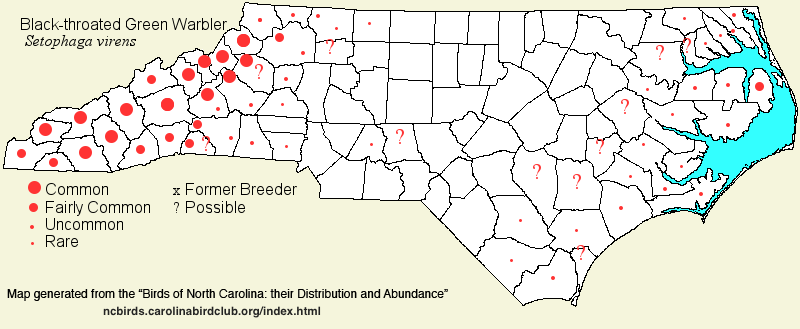 |  |
|
Black-throated Green Warbler - Setophaga virens PARULIDAE Members: | Search Common: Search Scientific: |
|
|
|||||||
| General Comments | The Black-throated Green Warbler has a fragmented breeding range, thanks to a separate subspecies -- "Wayne's Warbler" -- that nests in the lower Coastal Plain from southeastern Virginia to central South Carolina. Otherwise, the species has a breeding range similar to that of several other warblers -- across most of the Canadian boreal forest, south to the northeastern states and the entire Appalachian chain. In addition, it also nests in foothill ranges in the Piedmont, including a far outlier (small) population in the Uwharrie Mountains in the central Piedmont. Not surprisingly, it migrates across all parts of the state, and thus a diligent birder can see it in his or her county each year. As a breeder in the state, it prefers conifers or mixed hardwood-coniferous forest -- spruce-fir, spruce-hardwoods, and White Pine and hemlock mixed with hardwoods are favored in the mountains, though it does occur in pure hardwoods. In the foothills, it favors pines (and formerly hemlocks) mixed with hardwoods. Birds in the Coastal Plain are somewhat particular -- they are essentially only in nonriverine forests, favoring sites where Atlantic White Cedar or cypress are mixed with hardwoods, but they may occur in pure hardwoods. Floodplain forests are avoided (for reasons that are not obvious, as cypresses are often common there), but some birds do nest along small streams. In 2017, the NC Wildlife Resources Commission added the Wayne's race to its list of protected species, as State Endangered; the "E*" in State Status refers only to this race, not to the entire breeding population in the state. In migration, they occur with other warblers in hardwood forests, but they can be seen in conifers. | ||||||
| Breeding Status | Breeder | ||||||
| NC BRC List | Definitive | ||||||
| State Status | E* | ||||||
| U.S. Status | |||||||
| State Rank | S4B | ||||||
| Global Rank | G5 | ||||||
| Coastal Plain | Summer resident, and transient. In summer, variously rare to locally common in the eastern third to quarter of the province (but not along the coast), inland to the Dismal Swamp area, to Van Swamp (Washington), to Croatan National Forest, and to a few Carolina bays in Bladen; absent over considerable areas within this range, such as Holly Shelter Game Land. In spring, rare migrant over the region; uncommon in fall. Mainly late Mar to mid-Oct. There are about 9-10 records of birds in Dec and Jan, mainly along the coast, but once in Wayne; none presumably overwintered. However, 2 in Buxton Woods (Dare) on 20 Feb 2021 seem to be too early to be migrants. The species sings mainly from late Mar to mid-May, and can be rather silent by early Jun. Peak counts: | ||||||
| Piedmont | Sparse summer resident, and transient. In summer, formerly common (but decreasing due to loss/death of hemlock trees) in the South Mountains, and locally in the Hickorynut Gorge area; rare and local in the Brushy Mountains and the Uwharries (mainly at Morrow Mountain SP). Two singing males at Hanging Rock SP (Stokes) in 2020 suggests breeding there, as does four singing males there on 1 Jun 2022 and three there on 11 Jun 2024. Details of the summer distribution are still unclear among the various foothill ranges. In migration, in spring -- uncommon (more numerous in the western portions); in fall -- uncommon to fairly common. It is more numerous in fall than in spring, especially in the eastern portions, but is seldom common. Mainly mid-Apr to mid-May, and early Sep to mid-Oct. A specimen was found in Chapel Hill, 30 Nov 1977. Perhaps the only winter records are one photographed in a yard in Cary (Wake) on 12 Jan 2021, and one photographed in Morrisville (Wake) from 4 Dec 2024 - 1 Jan 2025. Peak counts: | ||||||
| Mountains | Summer resident, with migratory movements. Breeds over the entire region, but local; can be common to locally very common from the highest peaks to low elevation coves, but uncommon in many areas below 2,500 feet. Fairly common transient, but can be common in fall. Mainly late Mar or early Apr to mid-Oct. Peak counts (at least in summer): 71 tallied along Wilson Boundary Road (Yancey), 2 Jun 2017. | ||||||
| Finding Tips |
Should be easily found in late Apr or May in many areas of the higher mountains, such as along the Blue Ridge Parkway in mixed hardwood-spruce stands. May be one of the more common breeding birds in some foothill sites such as the South Mountains, as well. Also, in early and mid-Apr, easily found in Alligator River NWR. **** | ||||||
| Attribution | LeGrand[2025-05-09], LeGrand[2024-11-11], LeGrand[2023-04-10] | ||||||
| NC Map Map depicts all counties with a report (transient or resident) for the species. | Click on county for list of all known species. |
| NC Breeding Season Map Map depicts assumed breeding season abundance for the species. |  |